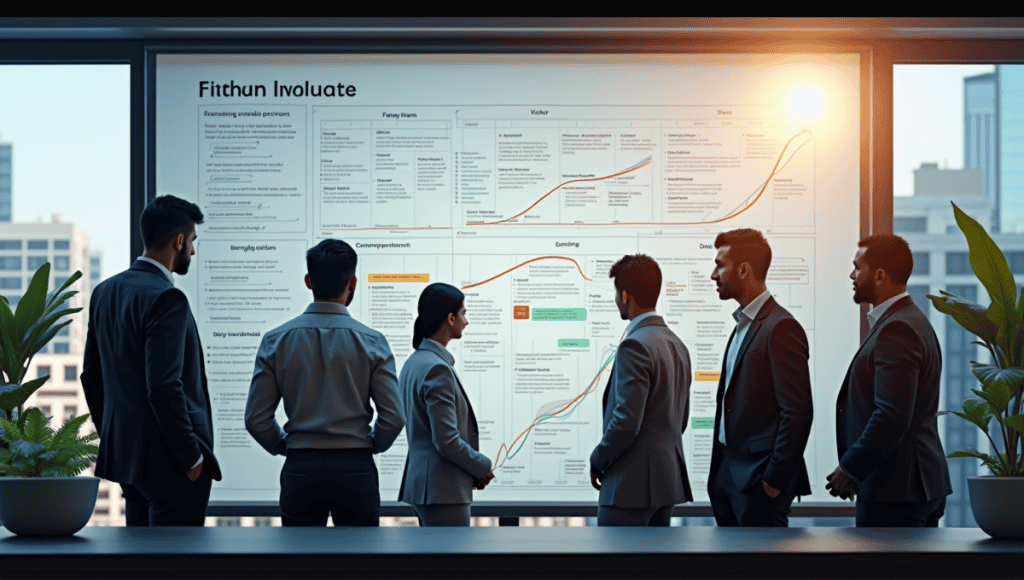As an industrial engineer with over two decades of experience, I can tell you that Kaizen and Six Sigma are the real deal when it comes to process improvement. Kaizen, the Japanese concept of continuous improvement, is a natural fit with the data-driven methodology of Six Sigma, and the two together are a killer combination to increase efficiency and quality. So how can combining Kaizen and Six Sigma change your operations and contribute to your success?
Kaizen and Six Sigma: An Overview

Kaizen and Six Sigma are both excellent methodologies for transforming business processes. Kaizen, which means “improvement” in Japanese, is all about continuously making small improvements. Six Sigma, on the other hand, is a data-driven methodology designed to minimize defects and process variations.
I’ve witnessed both of these methodologies transform businesses throughout my career. Kaizen encourages every person within an organization to provide improvement ideas. It’s about making small changes daily that will ultimately amount to significant improvements over time. Six Sigma leverages statistical analysis to identify and eliminate process defects.
The history of these methodologies is interesting:
- Kaizen originated in Japan after World War II.
- Six Sigma was developed by Motorola in the 1980s.
- The Toyota Production System adopted Kaizen principles.
- Six Sigma became popular after General Electric implemented it in the 1990s.
While their origins and founders differ, both methodologies serve the same purpose: Improving processes. Kaizen focuses on continuous small improvements. Six Sigma concentrates on making data-driven decisions and reducing process variability.
Together, these methodologies have a powerful effect. Kaizen encourages people to make continuous improvements, while Six Sigma ensures processes are stable in the long run through statistical analysis.
Implementing Kaizen and Six Sigma will improve employee engagement and make your processes more efficient. It’s a pragmatic strategy that has worked in many different industries.
The DMAIC Framework in Kaizen Six Sigma
The DMAIC framework is the foundation of Six Sigma projects. (DMAIC stands for Define, Measure, Analyze, Improve, Control.) Each step of this framework is improved by Kaizen principles to be more efficient and agile. During the Define stage, Kaizen promotes involving the people closest to the work to identify problems. This bottom-up strategy often finds problems that management overlooks. In the Measure step, you can apply the concept of visual management from Kaizen. Kaizen tools that support the DMAIC process:
- Gemba walks to identify problems
- A3 problem solving to analyze and plan improvements
- Daily huddles to track progress and control
My experience is that incorporating Kaizen events into Six Sigma projects speeds up improvements. These are short, focused improvement events to solve a problem identified in the Analyze step. In terms of Lean Six Sigma, track metrics. These might be cycle time reduction, defect rates, customer satisfaction scores, or other performance metrics. Whatever the case, track these metrics regularly to verify that performance is improving consistently.
Ultimately, remember that the goal of Lean Six Sigma is continuous improvement. After you complete the DMAIC process, you should already have new ideas for improvement. This circular process is the real power of combining Lean and Six Sigma.
Kaizen Tools for Six Sigma Process Improvement

Kaizen offers a set of tools that integrate seamlessly with Six Sigma. Using these tools will make your process improvement efforts more effective.
The 5S methodology (Sort, Set in order, Shine, Standardize, Sustain) is another core principle of Kaizen. When executing Six Sigma projects, implementing 5S will help organize your work area, further reducing waste and variability – the entire point of Six Sigma.
Value Stream Mapping is an excellent tool. Its purpose is to draw the entire process flow and identify bottlenecks and non-value-added steps. I can’t tell you how many times I’ve applied this tool and revealed significant inefficiencies in what people otherwise thought was a flawless operation.
Kaizen events, or Rapid Improvement Events, are brief, focused improvement activities. These are especially effective within a Six Sigma project where you can achieve quick wins and avoid the risk of a long-term project feeling like it’s stalling.
Visual management tools, like Kanban boards and Andon systems, enable the focus on controlling the process. After all, visual management is a great way to make any abnormalities immediately visible in Six Sigma projects and an opportunity to take quick action to put the process back on track.
Employee suggestion systems are one of the ultimate Kaizen tools where you collect all of your employees’ ideas. Often, they’ll come up with breakthrough ideas to complex issues you’re solving in a Six Sigma project.
Standard Work development is essential to Six Sigma, as reducing variation in any process must be defined through standard work. Meanwhile, Kaizen allows you to continuously improve these standards to ensure they keep pace with the process improvements you’re making.
Statistical Analysis in Kaizen Six Sigma
Statistical analysis is at the heart of Six Sigma methodology. There are basic statistical tools that Kaizen practitioners should understand, and Six Sigma practitioners can apply Kaizen principles to ensure statistical analyses are more actionable. The most important basic statistical tools that Kaizen practitioners should understand are Pareto charts, histograms, and scatter plots. These three visual tools are designed to help identify the biggest problems and potential correlations.
Six Sigma offers more advanced statistical tools, such as regression analysis, design of experiments, and statistical process control. Don’t worry if you aren’t yet familiar with these terms. With a little practice, you’ll find that they’re valuable allies for analyzing your data and uncovering potential solutions. Data collection is just as critical in Kaizen and Six Sigma methodology. Genchi Genbutsu, or “go and see,” is a guiding Kaizen principle to ensure that data is always collected at the source.
This approach will instantly make your Six Sigma analyses more accurate and relevant. Fishbone diagrams and the 5 Whys are common root cause analysis tools in both Kaizen and Six Sigma. These tools will help you deep dive into problems to discover additional underlying problems that you might not initially recognize. Control charts are a visual tool that monitoring process stability over time. Here’s an easy example of how you can use a control chart:
| Date | Process Output | Lower Control Limit | Upper Control Limit |
|---|---|---|---|
| 1/1 | 10 | 8 | 12 |
| 1/2 | 11 | 8 | 12 |
| 1/3 | 9 | 8 | 12 |
| 1/4 | 13 | 8 | 12 |
| 1/5 | 10 | 8 | 12 |
In this example, on 1/4, process output exceeds the upper control limit, indicating special cause variation that warrants more investigation.
Implementing Kaizen Six Sigma in Organizations
Implementing Kaizen Six Sigma is not just about mastering the tools and techniques. It’s about instilling a culture of continuous improvement across your organization.
Leadership is key to making this cultural shift. Leaders should do more than simply support improvement initiatives – they need to actively participate in them. I’ve seen many projects fail because leadership did not adhere to the process.
Training is also essential to successful implementation. You will need to train a select group of experts at each level:
- Yellow Belts (to support projects)
- Green Belts (to lead smaller projects)
- Black Belts (to manage larger projects)
- Master Black Belts (to train others and manage the program)
Project selection is perhaps the most essential step. Look for areas where an improvement will truly move the needle in your business or significantly improve customer satisfaction. Prioritize projects based on their potential impact and feasibility.
Resistance to change is another key challenge. Overcome this by involving employees in the improvement process and clearly communicating the WIIFM (What’s in it for me?). Additionally, celebrate quick wins early in the process.
Finally, sustaining improvements is often the most challenging part. You can keep the momentum going through regular audits, ongoing training, and a structured system for tracking and reporting results.
Keep in mind that Kaizen Six Sigma is not a one-time event. It’s a journey of continuous improvement. If you can adopt this mindset, you’ll make significant progress over time. This approach can be applied in various sectors, including kaizen in the service industry, where it can significantly improve work processes and customer satisfaction.
Case Studies: Successful Kaizen Six Sigma Applications

Here are some real-world examples of Kaizen Six Sigma in action. These case studies illustrate the flexibility and power of the combined methodology.
In the manufacturing industry, a car parts supplier used Kaizen Six Sigma to eliminate defects on the production line. The company started conducting daily Kaizen meetings and applied Six Sigma tools to analyze defect data. As a result, the company eliminated 40% of its defects and increased line productivity by 15%.
A major bank used Kaizen Six Sigma to optimize the loan approval process. The bank used Value Stream Mapping to visualize the process and identify process bottlenecks. Over time, the bank executed a series of Kaizen events to improve the process steps. As a result, loan approval time was reduced from 7 days to 2 days, which significantly improved customer satisfaction. This is a great example of how kaizen in finance can boost money management and operational efficiency.
In healthcare, a hospital applied Kaizen Six Sigma to reduce wait times for patients in the emergency department (ED). The hospital elected to use 5S to organize the space, conducted statistical analysis to forecast daily peak hours, and ultimately implemented a new triage system. The hospital reduced average patient wait time by 30% and healthcare patient satisfaction scores improved by 25%.
A small bakery used Kaizen Six Sigma to improve the business. Specifically, the bakery focused on reducing waste and standardizing how recipes were baked. After implementing the changes, the owner saw a 20% improvement in bakery profitability within six months.
The key takeaways from these case studies are:
- People driving the process changes is paramount
- Small changes can drive significant results
- Using data to solve problems is key
- Regular follow-up ensures changes become permanent
These examples prove that the Kaizen Six Sigma methodology can be used across various industries and business sizes. The trick is to customize the methodology to fit your unique situation and culture.
Challenges and Limitations of Kaizen Six Sigma
While Kaizen Six Sigma is a powerful methodology, it’s not without its challenges. Understanding these challenges can help you mitigate them and execute your improvement journey more effectively.
One common challenge is focusing on the tools instead of the results. It’s easy to become too attached to the tools and forget that the purpose of any technique is to improve your processes and results.
Balancing short-term Kaizen wins with long-term Six Sigma projects can be difficult. Kaizen events produce quick wins, and quick wins are important to keep your team motivated. However, some problems are too complex to fix in a week. This is where Six Sigma comes into play.
Resource allocation is another challenge. Doing Kaizen Six Sigma requires resources, particularly people’s time. You need to balance improvement with keeping the lights on.
It’s challenging to measure the intangible benefits. It’s one thing to measure a reduction in defects or cycle time, but measuring improvements in employee morale after Kaizen events or improvements in customer satisfaction is difficult. This is where kaizen metrics can play a crucial role in improving business processes and tracking progress.
Being flexible with how you apply Kaizen Six Sigma in different business environments is also a challenge. Manufacturing is different from a small business, which is different from a service business.
However, despite these challenges, I have found that the benefits of Kaizen Six Sigma far outweigh the challenges. With proper preparation and commitment, you can overcome these challenges and dramatically improve your processes.
Let’s Close This Out
Kaizen and Six Sigma are a formidable combination in process improvement. We’ve discussed their synergy, historical context, methodological frameworks, and the benefits of Kaizen. Using Kaizen tools in Six Sigma projects improves problem solving and employee engagement. Businesses that have adopted this combined strategy have seen impressive results. Just keep in mind that continuous improvement is a lifelong process. If you continue to optimize your processes, you’ll achieve long-term success in your company.






